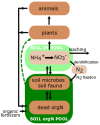Root-Derived Proteases as a Plant Tool to Access Soil Organic Nitrogen; Current Stage of Knowledge and Controversies
- PMID: 33918076
- PMCID: PMC8069566
- DOI: 10.3390/plants10040731
Root-Derived Proteases as a Plant Tool to Access Soil Organic Nitrogen; Current Stage of Knowledge and Controversies
Abstract
Anthropogenic deterioration of the global nitrogen (N) cycle emerges mainly from overuse of inorganic N fertilizers in nutrient-limited cropping systems. To counteract a further dysregulation of the N cycle, we need to improve plant nitrogen use efficiency. This aim may be reached via unravelling all plant mechanisms to access soil N, with special attention to the dominating high-molecular-mass N pool. Traditionally, we believe that inorganic N is the only plant-available N pool, however, more recent studies point to acquisition of organic N compounds, i.e., amino acids, short peptides, and proteins. The least known mechanism of plants to increase the N uptake is a direct increase of soil proteolysis via root-derived proteases. This paper provides a review of the knowledge about root-derived proteases and also controversies behind this phenomenon.
Keywords: nitrogen; proteolysis; soil.
Conflict of interest statement
The author declares no conflict of interest. The funders had no role in the design of the study; in the collection, analyses, or interpretation of data; in the writing of the manuscript, or in the decision to publish the results.
Figures
Similar articles
-
Do plants use root-derived proteases to promote the uptake of soil organic nitrogen?Plant Soil. 2020;456(1):355-367. doi: 10.1007/s11104-020-04719-6. Epub 2020 Sep 23. Plant Soil. 2020. PMID: 33087989 Free PMC article.
-
Plasticity in nitrogen uptake among plant species with contrasting nutrient acquisition strategies in a tropical forest.Ecology. 2017 May;98(5):1388-1398. doi: 10.1002/ecy.1793. Epub 2017 Apr 18. Ecology. 2017. PMID: 28263365
-
Root proteases: reinforced links between nitrogen uptake and mobilization and drought tolerance.Physiol Plant. 2012 May;145(1):165-79. doi: 10.1111/j.1399-3054.2012.01573.x. Epub 2012 Feb 23. Physiol Plant. 2012. PMID: 22242864 Review.
-
Vascular plant 15N natural abundance in heath and forest tundra ecosystems is closely correlated with presence and type of mycorrhizal fungi in roots.Oecologia. 1998 Jul;115(3):406-418. doi: 10.1007/s004420050535. Oecologia. 1998. PMID: 28308434
-
Uptake of organic nitrogen by plants.New Phytol. 2009;182(1):31-48. doi: 10.1111/j.1469-8137.2008.02751.x. Epub 2009 Feb 4. New Phytol. 2009. PMID: 19210725 Review.
Cited by
-
Poisoning from Alocasia × amazonica Roots: A Case Report.Toxins (Basel). 2025 Apr 10;17(4):189. doi: 10.3390/toxins17040189. Toxins (Basel). 2025. PMID: 40278687 Free PMC article.
References
-
- Suddick E., Whitney P., Townsend A., Davidson E. The Role of Nitrogen in Climate Change and the Impacts of Nitrogen-Climate Interactions in the United States: Foreword to Thematic Issue. Biogeochemistry. 2012;114:1–10. doi: 10.1007/s10533-012-9795-z. - DOI
-
- Lassaletta L., Billen G., Grizzetti B., Anglade J., Garnier J. 50 Year Trends in Nitrogen Use Efficiency of World Cropping Systems: The Relationship between Yield and Nitrogen Input to Cropland. Environ. Res. Lett. 2014;9:105011. doi: 10.1088/1748-9326/9/10/105011. - DOI
Publication types
Grants and funding
LinkOut - more resources
Full Text Sources
Other Literature Sources


